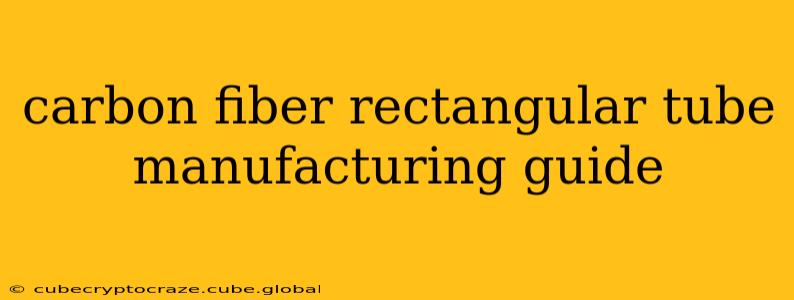Carbon fiber rectangular tubes are increasingly popular due to their exceptional strength-to-weight ratio, stiffness, and durability. This guide delves into the manufacturing process, exploring the various methods and considerations involved in creating these high-performance components. From raw materials to the finished product, we'll cover the key steps and challenges in carbon fiber rectangular tube production.
What are the Different Manufacturing Methods for Carbon Fiber Rectangular Tubes?
Several methods exist for manufacturing carbon fiber rectangular tubes, each with its own advantages and disadvantages. The most common techniques include:
-
Pultrusion: This high-volume production method involves pulling continuous fibers through a resin bath and then into a heated die that shapes the material into the desired rectangular profile. Pultrusion is ideal for producing long, consistent tubes with relatively simple cross-sections.
-
Filament Winding: This technique involves precisely wrapping continuous carbon fiber tows around a mandrel, layer by layer, with resin applied between each layer. The mandrel is later removed, leaving a hollow tube. Filament winding allows for intricate designs and precise control over fiber orientation, enhancing specific properties like strength or stiffness in particular directions. It’s especially suitable for high-performance applications requiring complex geometries.
-
Resin Transfer Molding (RTM): RTM involves placing dry carbon fiber preforms (typically woven fabrics or unidirectional tapes) into a closed mold. Liquid resin is then injected under pressure to fill the mold and impregnate the fibers. RTM offers good control over fiber volume fraction and resin distribution, resulting in high-quality components. It's versatile and can create complex shapes but might be less cost-effective for high-volume production than pultrusion.
-
Autoclave Molding: This process involves curing pre-impregnated carbon fiber (prepreg) in a heated, pressurized autoclave. Autoclave molding ensures complete resin impregnation and consolidation, leading to superior mechanical properties and consistent quality. However, it's more complex and expensive than other methods.
What are the Key Steps Involved in Manufacturing Carbon Fiber Rectangular Tubes?
Regardless of the chosen manufacturing method, several key steps are common to most processes:
-
Material Preparation: This stage involves selecting and preparing the raw materials, including carbon fibers, resins, and any additives. The fibers are typically chosen based on desired properties (e.g., high tensile strength, modulus).
-
Fiber Layup/Preform Creation: This involves arranging the carbon fiber tows or fabrics into the desired orientation within the mold or around the mandrel. The layup is crucial for achieving the desired mechanical properties.
-
Resin Impregnation: The fibers are impregnated with resin, either through a bath (pultrusion), injection (RTM), or pre-impregnation (prepreg). The resin system significantly impacts the final properties of the tube.
-
Curing/Consolidation: This step involves applying heat and/or pressure to cure the resin and consolidate the fibers, creating a rigid, strong structure. The curing process is highly critical and depends greatly on the resin type and manufacturing method.
-
Machining & Finishing: After curing, the tube may undergo machining operations to achieve precise dimensions, surface finishes, or to add features like holes or cutouts. Finishing processes might include sanding, painting, or coating for enhanced durability and aesthetics.
What are the Different Types of Resins Used in Carbon Fiber Rectangular Tube Manufacturing?
The choice of resin system significantly influences the properties of the finished carbon fiber rectangular tube. Common resins include:
-
Epoxy resins: These are widely used due to their excellent mechanical properties, good adhesion to carbon fibers, and relatively easy processing.
-
Polyester resins: These are less expensive than epoxy resins but generally offer lower mechanical properties.
-
Phenolic resins: These resins exhibit high temperature resistance, making them suitable for high-temperature applications.
-
Vinyl ester resins: These resins offer a balance between cost and performance, with good chemical resistance and mechanical properties.
What Factors Determine the Cost of Manufacturing Carbon Fiber Rectangular Tubes?
The cost of manufacturing carbon fiber rectangular tubes depends on several factors:
-
Manufacturing method: Pultrusion is generally the most cost-effective for high-volume production, while autoclave molding is the most expensive.
-
Material costs: The cost of carbon fibers and resins varies depending on the type and grade of materials used.
-
Tube dimensions and complexity: Larger and more complex tubes generally cost more to manufacture.
-
Production volume: Higher production volumes typically lead to lower per-unit costs.
How is the Quality of Carbon Fiber Rectangular Tubes Assessed?
Quality control is crucial in carbon fiber tube manufacturing. Various techniques are used to assess the quality, including:
-
Visual inspection: Examining the tube for defects like voids, delaminations, or surface imperfections.
-
Dimensional measurements: Verifying that the tube meets the specified dimensions and tolerances.
-
Mechanical testing: Conducting tests like tensile strength, flexural strength, and impact resistance to assess the mechanical properties.
-
Non-destructive testing (NDT): Techniques like ultrasonic testing or X-ray inspection can detect internal defects.
This guide provides a comprehensive overview of carbon fiber rectangular tube manufacturing. Remember that the optimal manufacturing method depends heavily on the specific application requirements, desired properties, and production volume. Consulting with experienced engineers and manufacturers is crucial for selecting the best approach for your needs.
